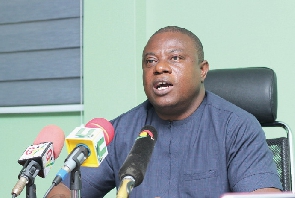Chief Executive of the Forestry Commission, John Allotey, has disclosed that as part of measures to combat illegal logging in the country, his outfit is employing initiatives to promote the commercial use of other equally valuable timber species known as Lesser-Used Species (LUS). He is confident this will not only help combat illegal logging but also enable the country to achieve the environmental objectives of sustainable forest and management (SFM) while transforming the domestic marketplace into an industrial hub for value-added processing. In the country, only 102 out of 715 tree species in the High Forest Zone are considered for stock survey; and until recently less than 60 percent of the yield on average was harvested, leaving about 40 percent un-harvested. Mr. Allotey noted that, for instance, the increase in-demand for timber as a raw material for construction, particularly in the real estate sector, puts a lot of pressure on forest reserves; a situation that can lead to illegal logging. As such, promoting commercial exploitation and use of LUS and plantation timber in the construction space is expected to enhance the availability and supply of legal timber, particularly for the domestic market. “Ghanaians and consumers of timber all over the world have a high taste for traditional tropical timber species such as Mahogany, Odum, Dahoma, Sapele and Masonia, which are becoming scarce because of over-exploitation. To avoid a complete extinction of these prime species and the consequent ecological imbalance, there is a need to shift attention from these few prime species by exploring the market potential of other timber species that may be of economic value." “For example, trade statistics generated by the Timber Industry Development Division (TIDD) of the Forestry Commission show that, in 2021, timber consumed on the domestic market was in excess of 473,000m3 – which is more than one and a half times the total volume of timber and timber products export; amounting to 303,229 m3 within the same period… with some variations in value, though,” he said at the exhibition of lesser-used and plantation timber products in Accra. The event was organised by the Kumasi Wood Cluster Association (KWC) in collaboration with the Chamber of Construction Industry and the Timber Industry Development Division of Forestry Commission, with funding support from the UKaid and the UKTTF on the theme ‘Emerging Wood Species Fit for Housing Development and Construction Works in Ghana’. It also saw the Minister for Works and Housing, Francis Asenso-Boakye, stressing that given the current over-exploitation of timber, knowledge about LUS will help reduce pressure on the well-known species and also provide the housing sector with several alternatives for construction purposes. He also underscored the need to innovate and reduce the high reliance on imports by supporting local industry. He entreated players in the real-estate industry – through stakeholder dialogue with manufacturers of wood products to create a market that is mutually beneficial. For his part, the Executive Director of KWC, Gustav Adu, noted that the scarcity of timber as raw material is because Ghanaian timber suppliers and consumers are excessively fixated on a narrow spectrum of timber species. He however urged the domestic market to change the status quo in order to encourage growth in the space. In line with this, his outfit launched a Compendium on Lesser-used Timber species in Ghana to make available physical and technical information on LUS/LKS timber species in an easy-to-read manner.
Business News of Wednesday, 19 October 2022
Source: thebftonline.com













